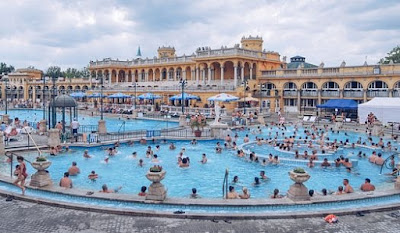Hungary has a spa culture as it is a land of thermal water.
The Central European country of Hungary has a rich and vibrant culture characterized by a rich and vibrant folk art tradition, love for sports and spas, a unique Magyar cuisine, and more.
Ethnicity, Language, and Religion in Hungary
Hungary is home to a population of 9,825,704 individuals. Hungarian constitutes 85.6% of the country’s population. Romani and Germans are the second and third biggest minority ethnic groups, respectively. Hungarian is the official language of the country and is spoken by 99.6% of the population. English, German, and Russian are some of the other languages spoken in the nation. 37.2% of the population is affiliated to the Roman Catholic Church. Calvinist, Lutheran, and Greek Catholic account for 11.6%, 2.2%, and 1.8% of Hungary’s population, respectively.
Hungarian Cuisine
The country’s cuisine is dominated by the cuisine of its primary ethnic groups, the Magyars. Meats, seasonal fruits and vegetables, dairy products, and fresh bread are the main constituents of the traditional Hungarian cuisine. Beef, pork, and lamb are heavily consumed. Other meats like lamb, turkey, duck, fish, and even game meats are eaten. The Hungarian sausages and salamis are famous for their top quality and low prices. Bread is consumed in almost all meals. Other bakery products like pastries and buns are also popular. Some favorite dishes of the Hungarian people include paprika chicken with noodles, sour cream, and bread with stuffed cabbage, goulash and other meat stews, soups, smoked meat, casseroles, etc.
Pálinka (a fruit brandy), wine including Tokaji (a label for wines from Hungary’s Tokaj-Hegyalja region), Zwack Uncium (a liqueur produced by a Zwack family using a secret recipe) are some of the popular Hungarian beverages.
Literature and the Arts in Hungary
Hungarian literature refers to writings in the Hungarian language. Originally, a runic-like was used to write in Hungarian but later, the Latin script was used. The oldest written work in Hungarian dates back to the 11th century. It was called Establishing charter of the abbey of Tihany and had some Hungarian terms. The first published work written entirely in Hungarian was the 12th-century Funeral Sermon and Prayer. Initial literary works in the language focussed on religion, history, and legends. In the 15th century, Renaissance literature flourished in the region. Chronica Hungarorum was the first published book in Hungarian. The library set up by Matthias Corvinus is Hungary’s oldest library. It was set up during the rule of King Matthias in the 15th century. Today, many Hungarian literary works have been translated into other languages that have become popular worldwide.
Hungarian art has a long history. The country’s folk art incorporates both Baroque and Renaissance elements. Ceramics, pottery, and embroidery are the most highly developed forms of Hungarian folk crafts. Black pottery and Herend porcelain from Hungary are famous. The former is made of black clay and exhibits centuries-old traditional Transdanubian folk patterns. Every pottery item is unique as it is handcrafted. The latter is a ceramic company specializing in the production of luxury hand painted and gilded porcelain. Hungarian embroidery work is known for its intricate designs and beauty.
Performance Arts in Hungary
Hungary has a rich heritage of music ranging from traditional Hungarian folk music to classical and contemporary music. The country has also produced many internationally famous musicians and composers. The country’s folk music has significantly influenced the music of neighboring countries like Poland, Slovakia, and Romania. Busójárás carnival is a major folk music event held in Mohács every year. Jumping dances called Ugrós, a circle dance called Karikázó, new style dances called Csárdás, Verbunkos and Legényes (solo dances for men) are some of the folk dances of Hungary.
Sports in Hungar
Hungarians have a strong culture of sports. Many Hungarians participate in sports. The country is one of the top performers in the Olympic Games. The country has the world’s second highest gold medals per capita in the Summer Olympics. Ferenc Puskás, a footballer, is one of the most famous Hungarian sportspersons. He scored 84 goals in the 85 international matches in which the Hungarian national team has participated. Hungarians have a strong legacy in water sports like water polo, canoeing, and swimming. The Duna and Tisza rivers and lake Balaton are the top places for practicing water sports. Hungarian athletes also excel in saber fencing. The country also has a strong basketball and ice hockey team.
Spa Culture of Hungary
Hungary has a spa culture as it is a land of thermal water. The Hungarian spas feature Roman, Turkish, Greek, and other architectural elements in their design. The first Hungarian spas were started by the Romans. Budapest, the country’s capital , has one of the richest thermal water supplies in the world. Nearly 450 public baths are located in the country. Healing services are often offered at the spas in the country.
By Oishimaya Sen Nag
•culled from www.worldatlas.com


No comments:
Post a Comment